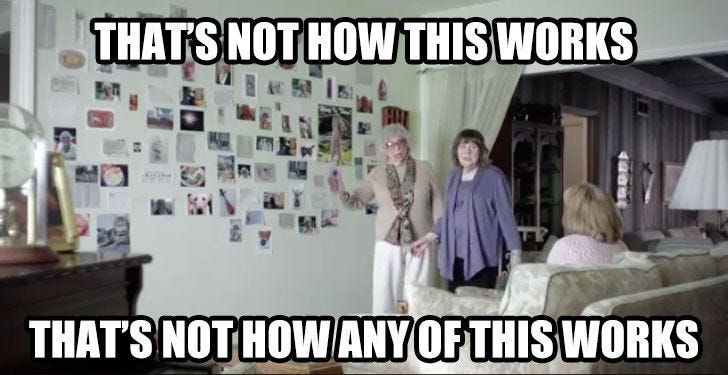Three days, two tech conferences

It is 104 degrees, 120 on the sidewalk, but less humid than I am used to, which is nice.
As always, Las Vegas’ kaleidoscope of people is disorienting.
It’s one of the most interesting places in the world for people watching— desperate to prove Bill Langewiesche’s “You should not see the desert simply as some faraway place of little rain. There are many forms of thirst.”
I am always uncomfortable here.
I know myself well enough to know I can’t go straight into a convention and not experience psychic pain. If I just leap into it, the ‘peopling’ parts of my brain throw sparks and scream like twisted steel. So I practiced being social from the time I left my house.
I chatted up the airport employees, my Lyft driver, the hotel staff — everyone who presented me with an opportunity for dialog. It gets easier with each person, but never frictionless.
Part of it is my personality. Part of it is in reaction to the empty (often passive-aggressive) small talk of the South I grew up surrounded by. Part of it is a battle between curiosity and a desire to “mind my own business”, both of which have served me well.
By the time I’ve got my badge and swag bag, I can approximate the social skills of a normal, functioning adult. This trip I actually have two badges, because I am attending two conventions at the same time.
This is stupid. Never do this. It will leave you exhausted and hurting, even without following the Hunter S. Thompson event playbook.
I spend three days bouncing back and forth between Mandalay Bay and the Aria for VMWorld and Oktane, respectively.
Walking around VMWorld’s vendor floor and listening in on keynotes confirms a thought I had on the plane ride — this will be my last VMWorld, there’s nothing here for me anymore. That’s partially because of where I’m focusing my career (cloud) and partially because of VMware.
There are groups within VMware doing interesting things (or at least wanting to), but the company as a whole struggles to execute and is moving much too slowly (and randomly) to remain relevant. Their leadership communicates a new idea of “who VMware is” every year even as the company hasn’t meaningfully aligned to whatever identity they were supposed to be several years prior.
While Pat Gelsinger was telling his audience that the tipping point in enterprise cloud is still five years away, Google’s Diane Greene (one of the founders of VMware, ironically), was telling the Oktane crowd that the tipping point has already come.
Obviously they each have their reasons for spinning a specific vision of the market, but one of those visions is “come on everybody, it’s time to move”, the other is “we’ll catch up with you later”.
Watching other VMWorld attendees furiously take notes about news and technical concepts that would be quaint or old hat somewhere like AWS ReInvent seems to support Gelsinger’s take, that VMware is right in slowly building bridges to the future. But they may be building the wrong bridges.
With all the talk of VMware enabling customers to migrate their existing VMs to the cloud, I can’t shake the sense that VMware management either really doesn’t understand cloud or is hoping customers don’t.
Moving VMs from on-prem to cloud or between clouds isn’t a thing people should be doing. It’s OK as a short-term tactic, but migrating VMs is really just moving old problems and creating new ones; yet VMware seems to have focused a significant portion of their latest strategy around the idea.

At this point, it feels like VMware is throwing spaghetti at the wall and hoping the long tail of legacy tech lasts longer than anyone is expecting. This isn’t just a VMware problem (Look at the entire new DellEMC federation, for example.), but it does make me a little sad, because VMware had an opportunity to lead and be more than the shrinking funnel for hardware sales that they’ll become.
I spend most of my time at Oktane, talking to other customers and the more future-focused vendors there.
The first part of Oktane’s opening keynote runs long before they bring Malcolm Gladwell onstage, with what I assume is the hope that he will compress his talk into what remains of the keynote timeslot.
He does not. Malcolm Gladwell does not care about “only having 15 minutes left”. Malcolm Gladwell is honey badger, and provides the spectacle of watching hundreds of people who need to be somewhere else fidget and anxiously figure out what to do.

Gladwell gives a 30 min talk that leads with a description of childhood leukemia in the 1950s and the explosively hemorrhagic deaths of small children. In this moment I forgive him for his past half-baked theories.
Those extra 15 minutes have the effect of throwing the entire rest of the morning off.
A customer panel I am part of starts with the presenters scrambling to set up their A/V. Nothing works right, and one of the presenters starts the talk only to get flustered and abandon the podium, looking desperately at his co-presenter to save him.
I feel bad for both of them. Fortunately, the heckling is kept to a minimum.
This is the fun stuff you see at smaller conferences.
Okta does a good job of building on the vision they shared at last year’s Oktane, where you could see the rough shape of something coming together.
They want to be the glue that ties SaaS services together and extend their platform further into devices and infrastructure. It’s a good plan, and no one else is really executing on it in a similar way. There are API integration platforms(Mulesoft, Apigee, whatever) that let companies easily plug all their apps together, but Okta is doing it with identity.
They’re becoming the Active Directory of the cloud, which is impressive considering that Microsoft literally makes an Active Directory product for the cloud.
Where VMWorld felt like the past struggling to reach into the future, Oktanewas the future.
After three days of having to be “on”, I am worn out. I make a last sprint of being social on the car ride to the airport, spending what is left of my socializing fuel. I can’t imagine what the people running vendor booths must feel like after a week of feigning interest and pitching their product.
I used to think the point of going to conventions was to learn things. Then I started going to conventions and figured out there really wasn’t much there to learn outside of customer-led sessions.
It’s easy to wander from session to session, never engaging with anyone, but there’s little value in that. As much as I hate the concept of “networking” as it relates to people, it is necessary.
Establishing relationships with other customers gives you resources to help solve problems and get advice. Strengthening relationships with vendors helps you get things done, especially with the big vendors to which you are by default just an account number.
If it weren’t for forcing myself to be social I wouldn’t know as many escalation managers, product managers, and engineers as I do now. These relationships are invaluable, because they’re the people who can actually help you if you’re trying to get traction with a support ticket or feature request.
Meeting these people is what makes going to cities you don’t particularly like and getting out of your social comfort zone worth it. In many cases, these aren’t just relationships of utility either. You’ll meet a lot of legitimately interesting people doing interesting things. Some of them may even become friends.